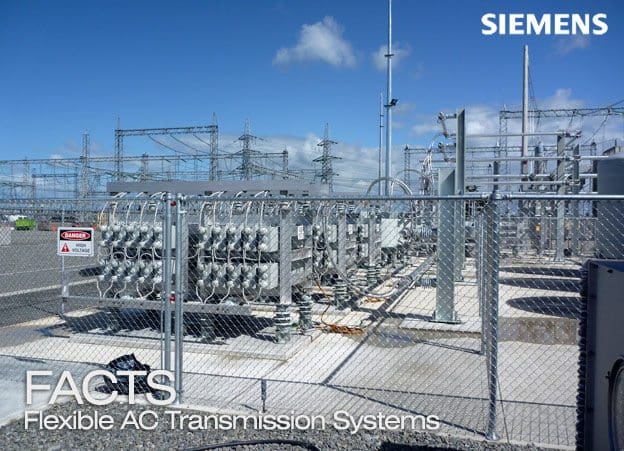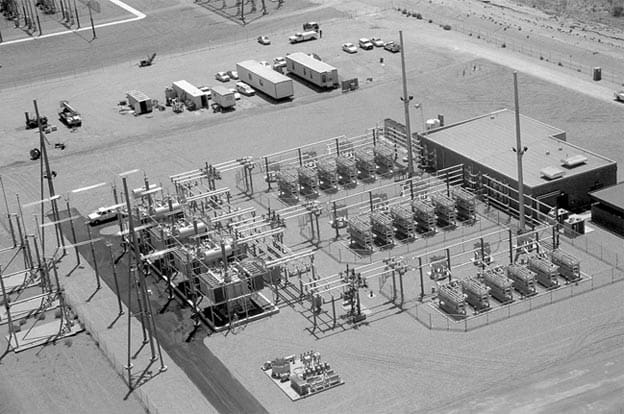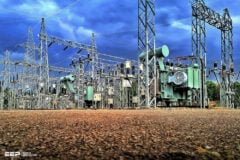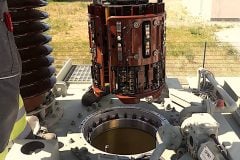The acronym FACTS stands for “flexible AC transmission systems”. These systems add some of the virtues of DC, i.e., phase independence and fast controllability, to AC transmission by means of electronic controllers. Such controllers can be shunt or series connected or both. They represent variable reactances or AC voltage sources.

They can provide load flow control and, by virtue of their fast controllability, damping of power swings or prevention of subsynchronous resonance (SSR).
Typical ratings of FACTS controllers range from about thirty to several hundred MVAr. Normally they are integrated in ac substations. Like HVDC converters, they require controls, cooling systems, harmonic filters, transformers, and related civil works.
SVCs have been used successfully for many years, either for load (flicker) compen-sation of large industrial loads (arc furnaces, for example) or for transmission compensation in utility systems.
Figure 1 shows a schematic one-line diagram of an SVC, with one thyristor-controlled reactor, two thyristor switched capacitors, and one harmonic filter.

1 – Transformer
2 – Thyristor- controlled reactor (TCR)
3 – Fixed connected capacitor/filter bank
4 – Thyristor-switched capacitor bank (TSC)
The thyristor controller and switches provide fast control of the overall SVC reactance between its capacitive and inductive design limits. Due to the network impedance, this capability translates into dynamic bus voltage control. As a consequence, the SVC can improve transmission stability and increase power transmission limits across a given path.
Harmonic filter and capacitor banks, reactors (normally air core), step-down transformers, breakers and disconnect switches on the high-voltage side, as well as heavy-duty buswork on the medium voltage side characterize most SVC stations. A building or an e-house with medium voltage wall bushings contains the power electronic (thyristor) controllers. The related cooler is usually located nearby.
Figure 2 shows the related one-line diagram. STATCOM is the electronic equivalent of the classical (rotating) synchro-nous condenser, and one application of STATCOM is the replacement of old synchronous condensers.

The need for high control speed and low maintenance can support this choice. Where the STATCOM’s lack of inertia is a problem, it can be overcome by a sufficiently large dc capacitor. STATCOM requires fewer harmonic filters and capacitors than an SVC, and no reactors at all.
Like the classical fixed series capacitors (SC), thyristor-controlled series capacitors (TCSC) [19, 20] are normally located on insulated platforms, one per phase, at phase potential. Whereas the fixed SC compensates a fixed portion of the line inductance, TCSC’s effective capacitance and compensation level can be varied statically and dynamically. The variability is accomplished by a thyristor-controlled reactor connected in parallel with the main capacitor.
This circuit and the related main protection and switching components are shown in Figure 5.10. The thyristors are located in weatherproof housings on the platforms. Communication links exist between the platforms and ground. Liquid cooling is provided through ground-to-platform pipes made of insulating material.
Auxiliary platform power, where needed, is extracted from the line current via current transformers (CTs). Like most conventional SCs, TCSCs are typically integrated into existing substations. Upgrading an existing SC to TCSC is generally possible.

A new development in series compensation is the thyristor-protected series compensator (TPSC). The circuit is basically the same as for TCSC, but without any controllable reactor and forced thyristor cooling.
The thyristors of a TPSC are used only as a bypass switch to protect the capacitors against overvoltage, thereby avoiding large MOV arrester banks with relatively long cool-off intervals. While SVC and STATCOM controllers are shunt devices, and TCSCs are series devices, the so-called unified power flow controller (UPFC) is a combination of both [21].
Figure 4 shows the basic circuit. The UPFC uses a shunt-connected transformer and a transformer with series-connected line windings, both interconnected to a dc capacitor via related voltage-source-converter circuitry within the control building.

A more recent FACTS station project involves similar shunt and series elements as the UPFC, and this can be reconfigured to meet changing system requirements. This configuration is called a convertible static compensator (CSC).
The ease with which FACTS stations can be reconfigured or even relocated is an important factor and can influence the substation design. Changes in generation and load patterns can make such flexibility desirable.
Figure 5 shows a 500-kV AC feeder (on the left side), the transformers (three single-phase units plus one spare), the medium-voltage bus, and three thyristor-switched capacitor (TSC) banks, as well as the building that houses the thyristor switches and controls.

The SVC shown in Figure 6 is connected to the 420-kV Norwegian ac grid southwest of Oslo. It uses thyristor controlled reactors (TCR) and TSCs, two each, which are visible together with the 9.3-kV high-current buswork on the right side of the building.

Figure 7 show photos of two 500-kV TCSC installations in the U.S.. The platform-mounted valve housings are clearly visible. Slatt (U.S.) has six equal TCSC modules per phase, with two valves combined in each of the three housings per bank.

Reference: High-Voltage Power Electronic Substations by Gerhard Juette and Asok Mukherjee (Siemens AG)











Very good FACTS in systems power
hi
i am student M.s power system electric
Report of reactive power optimization of industrial projects in the pipeline need
In practice, what works and measures to optimize the reactive power occurs.
؟
Please help me
Thanks
send me : sajjadsayadi@gmail.com
Hello, I’m developing a 60kV, 50MVAR FACTS system in a system isolated from Peru’s interconnected electrical grid. My research involves the SVC-STATCOM application.